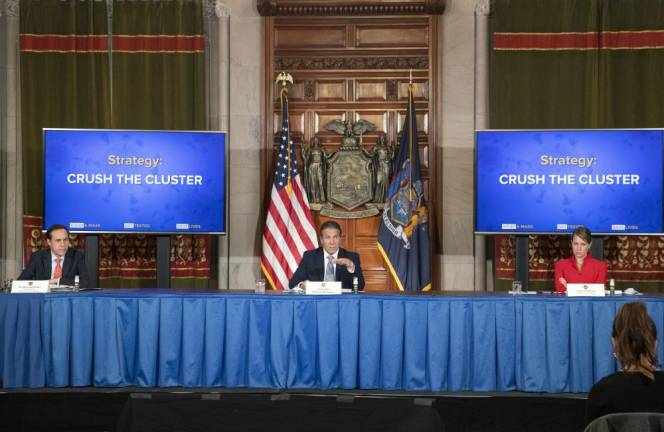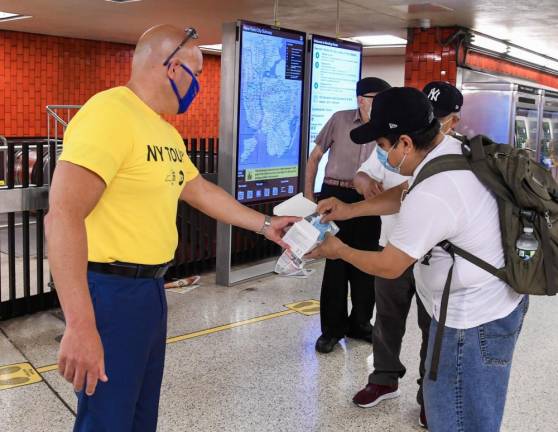How Ready is NYC for a Second Wave?
What New Yorkers did - and didn’t - learn from the first coronavirus wave, and recent outbreaks in Brooklyn


Whether a second wave of COVID-19 is about to crash over New York City has as much to do with the behavior of New Yorkers as of the coronavirus.
Indeed, health experts understand the behavior of the virus far better now than they did last February and March, when the first wave was building. The behavior of New Yorkers, on the other hand? Well, it is what it is.
The rebellion against lockdowns in Southern Brooklyn grabbed much attention, and was generally explained as a resistance to government mandates by groups of Orthodox Jews invariably described as “insular.”
Burning masks on the streets of Borough Park is, to be sure, not an approved public health message. “When I’m on the street, I don’t have to wear a mask, just like the president,” one of the organizers, Heshy Tischler, told The Forward, shortly before his arrest for encouraging an assault on a reporter.
Based on the coronavirus positivity rate at the White House, Tischler’s choice of a behavioral model can be challenged.
But the larger question right now is whether, in general, New Yorkers and their city, having had six months to prepare, are ready. Despite much self-congratulation, a close look at some key topics suggests not.
MASKS
Health experts, after some initial uncertainty, now say with confidence that wearing a mask is the simplest, most cost effective measure an individual can take to limit the spread of the virus.
Limit is the key word. Estimates from places where mask use reaches 95 % suggest infections can be reduced by a third. That is why experts always combine the recommendation to wear a mask with social distancing and hand washing.
So how are New Yorkers doing? “Mask compliance is abysmal,” Sarah Peltz, a podcaster about transit and city affairs, reported from her home in Bay Ridge. She notes that many of her neighbors sport MAGA sympathies which may influence their actions.
Looking more broadly than Brooklyn, about 3 out of 4 New Yorkers report in a survey via Facebook that they always wear a mask in public, according to The Institute for Health Metrics and Evaluation (IHME) at the University of Washington. That is the highest reported rate of mask use in the country (Wyoming is 38 percent), but still a good bit short of the target of 95% for universal use.
This survey, which is conducted in more than 100 countries, doesn’t measure the gap between this self-reported mask use and reality. The one regular tally of New Yorkers observed wearing masks, in the subways, is encouraging.
“It remains very high, more than 90 percent, and it seems to have gone up since we announced a $50 fine for non-compliance,” said Shams Tarek, a spokesman for the Metropolitan Transportation Authority. In the month since fines began on Sept. 14, only seven summonses – “yes, seven” – have been issued, Tarek reported. But in 7,328 other encounters with authorities riders put on a mask they already had or were given one.
TESTING AND TRACING
The city’s system of identifying infections and isolating those exposed still lags behind its own goals. When the coronavirus infections surged in Orthodox neighborhoods, the de Blasio administration acknowledged that they had very few Yiddish speakers to trace coronavirus infections.
Citywide, four in ten New Yorkers identified as having been exposed to an infected person cannot be contacted or do not cooperate with contact tracing. Federal immigration enforcement sent a shudder through the contact tracing operations when it was revealed last week that ICE agents were at times masquerading as NYPS officers.
The Test and Trace Corps officials stress that they do not share information even with local law enforcement. But establishing trust remains a challenge in the city’s large immigrent communities.
SPEED
The biggest lesson of the first wave is that acting fast is essential. The virus spread faster than the speed of political decision making, both locally and nationally. The situation is clearly improved in some ways.
“Our robust testing efforts allow us to narrow hot spot areas down to the range of a block,” Governor Andrew Cuomo said Friday. “As part of our Cluster Action Initiative, there are new restrictions in six clusters in the State, which allows us to stop the spread from these clusters and protect our progress in the fight against COVID-19.”
But this improved visibility will ultimately be of limited effectiveness unless officials have the trust of communities for the actions they then take. The poor coordination between the governor and the mayor does not inspire confidence and fogs the crucial task of communicating why hard measures, like restrictions on the size of worship services, are needed.
The governor complained repeatedly last week that local officials – by which he meant the mayor – were failing to enforce already established measures to curtail spread.
Moreover, city and state agencies did not always seem to be playing from the same sheet. Thirty schools in south Brooklyn, run by the city Department of Education, were ordered shut, to halt the spread. Yet buses and subways, run by the state, kept rolling through the neighborhoods.
“At no point during this pandemic have we reduced service due to any lockdowns and we would not do that,” said Shams Tarek, the MTA spokesman.
That may well be the right call. But the public has no way to tell when decisions are coherent or incoherent.
“[Mask-wearing on subways] remains very high, more than 90 percent, and it seems to have gone up since we announced a $50 fine for non-compliance.” Shams Tarek, a spokesman for the Metropolitan Transportation Authority